When it comes to ‘Big Australia’ shills, you would be hard pressed to find a bigger rent-seeker than Dr Shane Geha, managing director of EG – “a leading real estate investment fund manager” – whose business profits directly from mass immigration. According to their website:
As founding Managing Director of EG’s Urban Planning business, Shane bears overall responsibility for all EG’s rezoning projects. Shane has extensive rezoning experience and brings a combination of practical know-how and value creation skills to projects he is involved in.
He was previously a director of a private company managing over AU$200 million in property development in NSW and the ACT.
Geha’s LinkedIn profile also tells us that he’s up to his neck in the ‘rezoning’ business:
His focus is working closely with clients on property uplift strategy and implementation and has worked on multiple rezoning projects including some of the largest land use changes in both size and value in Sydney and New South Wales.
Geha’s vested interest has been exposed previously by MB (here, here and here).
Last year, Geha ridiculously claimed that more immigration was required to “bust congestion”, even though Blind Freddy can see that piling tens of thousands of migrants into our cities is the key driver of said congestion.
As I noted at the time:
You don’t solve alcoholism by drinking more. You don’t solve diabetes by upping your sugar intake. And you certainly don’t solve congestion by raising demand via importing more people.
Geha is back talking his book once again, this time claiming that more immigration is required to avoid recession, to solve an ageing population, and to improve liveability in Sydney and Melbourne:
Dr Geha says as fears of a recession grow, Australia needs migrants “more now than ever before” to boost economic output and stem the damage to the hard-hit education, tourism and agriculture industries.
“We’ve got a precarious economy that needs itinerant workers, needs students and tourists,” he said. “(These industries) are entirely reliant on migrant populations for work. They need these temporary workers, people who are ready to clean beds, pick cotton, pick fruit. There’s going to be a huge shortage of these people. They’re essential to our GDP.”
Dr Geha says in order to pay for healthcare for that ageing demographic, more migrants are needed to replace the tax revenue “generated by the working majority aged between 20 and 60”.
The only option other than “importing them” is “breeding them”, he argues, and Australian households are only having 1.9 children on average, “not even replacing mum and dad”. “We have to import people, it’s our destiny,” he said. “The only other options are to increase taxes, go into austerity, reduce services.”
Common arguments from anti-immigration commentators about increased congestion, lower standard of living, diminished access to services and lower per-capita GDP are “also unfounded, they’re nonsense points”, Dr Geha added.
“To have functional, world-class cities you need to be somewhere between eight and 10 million at least,” he said. Sydney’s population is currently around 5.23 million.
“The densities of some of the most beautiful cities in the world are multiples of Sydney. Sydney is 417 people per square kilometre. London is five times the density, Paris is four times, Tokyo is 10 or 11 times.”
Bigger, denser cities have more effective public transportation, the scale needed for “24/7 services” and also have safer streets, he argues, because density means there are “eyes and ears” everywhere.
Australia has run strong immigration for 17 years with disastrous results. Per capita GDP growth has plunged:
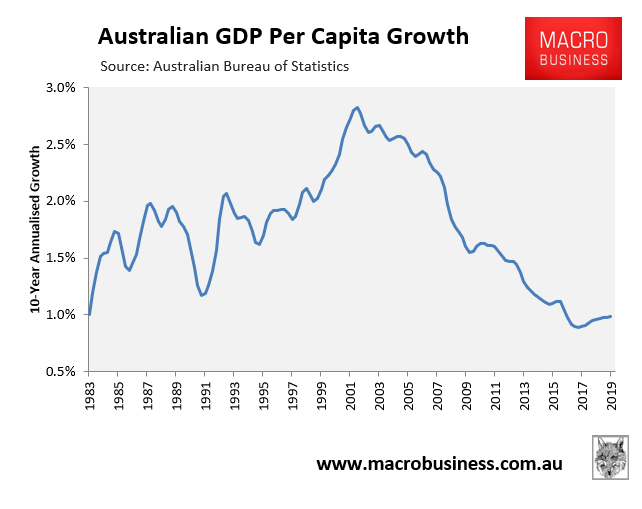
As has real per capita household disposable income:
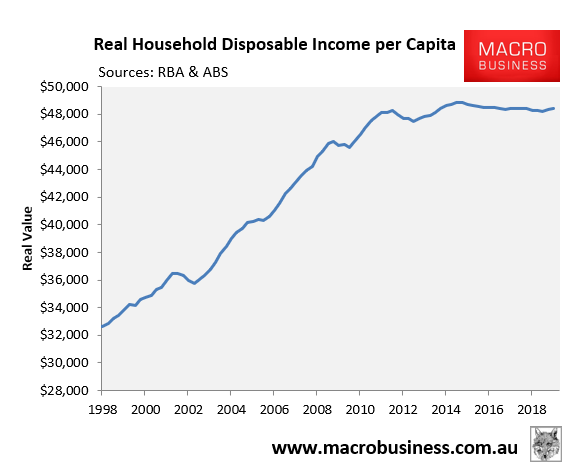
Moreover, where are all these labour shortages that Geha speaks of?
Wage growth is running near record lows, whereas the labour underutilisation rate is stuck near 14%, indicating a massive oversupply of workers:
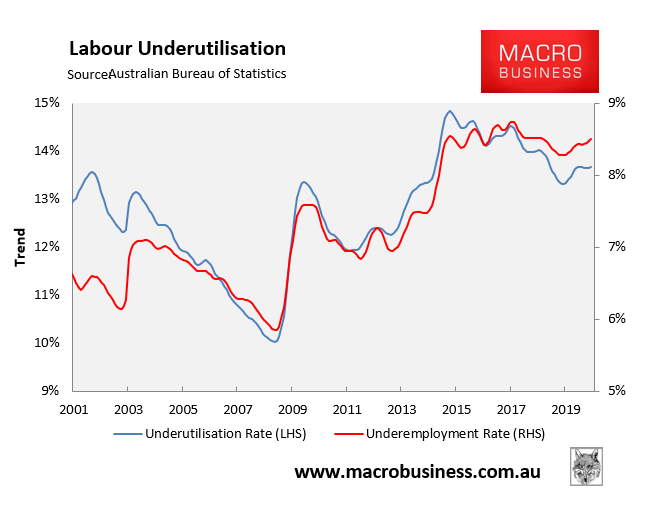
Ramping up immigration would obviously add to the overcapacity and drag wages and per capita growth even lower.
Geha’s claim that Australia needs to import people “in order to pay for healthcare for that ageing demographic” and “to replace the tax revenue generated by the working majority aged between 20 and 60” is pure ponzi-economics. It takes no account of the extra costs created (e.g. infrastructure, public services, liveability and environment) and ignores the fact that these migrants will also grow old, thus requiring an ever increasing immigration intake.
Next, Geha’s claim that “to have functional, world-class cities you need to be somewhere between eight and 10 million at least” is asinine.
How does Geha explain the fact that only one city ranked in the top 10 of the 2019 Mercer Quality of Living Index:
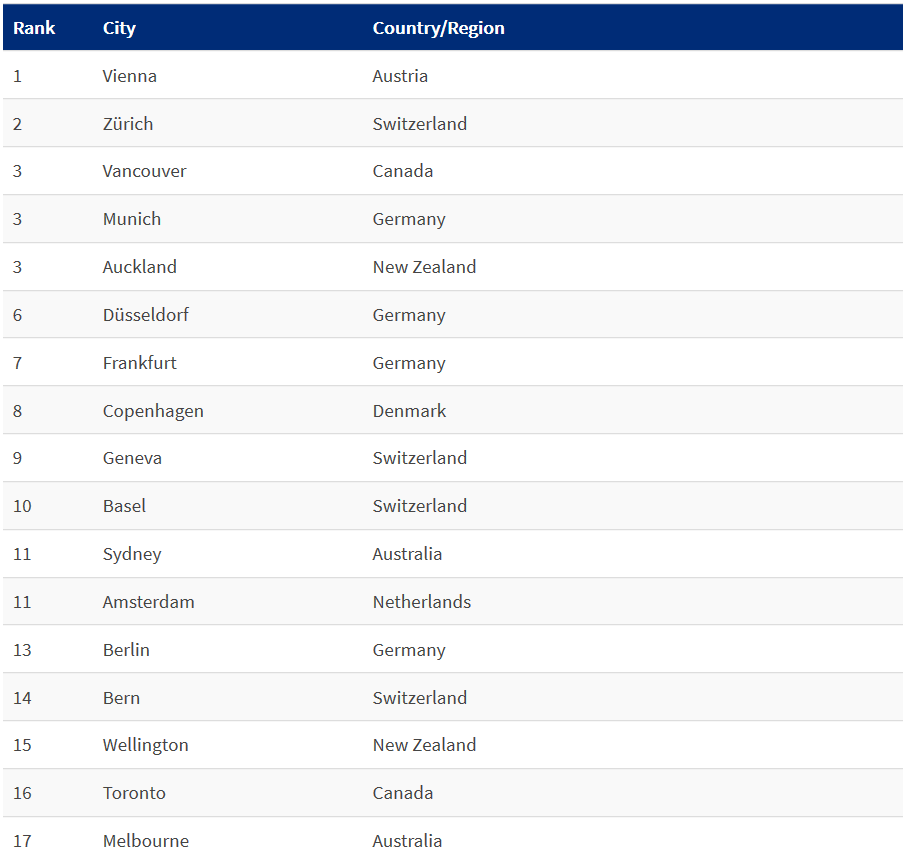
Had an urban population of greater than 3 million people?
- Vienna: 2.6 million
- Zurich: 1.8 million
- Auckland: 1.7 million
- Munich: 6 million
- Vancouver: 2.5 million
- Dusseldorf: 1.2 million
- Frankfurt: 2.3 million
- Geneva: 1 million
- Copenhagen: 2 million
- Basel: 550,000
Moreover, there are many struggling cities that are much larger than any in Australia, including Mexico City, Buenos Aires, Moscow, Sao Paulo, Rio de Janeiro, Manila, Jakarta, Istanbul, Bangkok, Lagos, and Tehran.
So what’s Geha’s point? Is bigger necessarily better? Obviously not.
The fact of the matter is that Australia has run a turbo-charged migrant intake for 17 years with obvious results: roads, public transport, schools and hospitals have all become over-crowded despite record infrastructure investment. People have also been shoe-horned into smaller and more expensive housing. Upping the migrant intake even further, and expecting livability to magically improve, is the very definition of insanity.
Infrastructure Australia’s modelling for Sydney and Melbourne unambiguously disproves Geha’s propaganda. As shown below, traffic congestion, commute times, and access to jobs, schools, hospitals and green space are all projected to worsen as Sydney’s and Melbourne’s populations balloon to 7.4 million and 7.3 million people respectively by 2046:
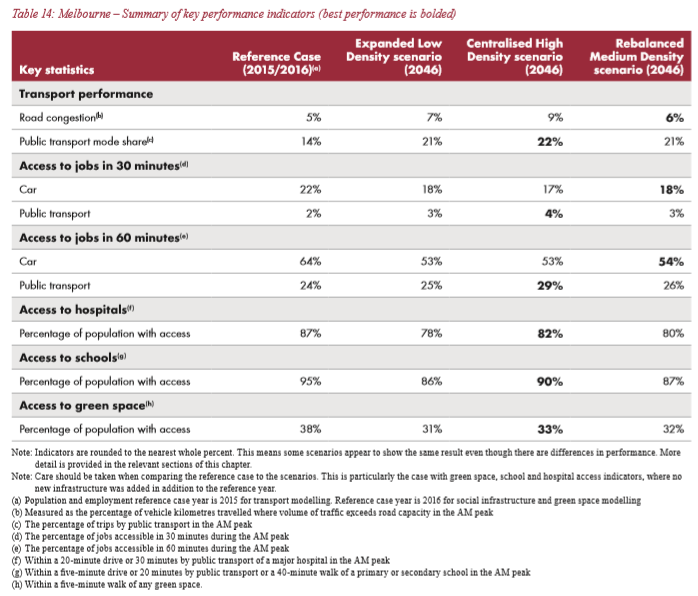
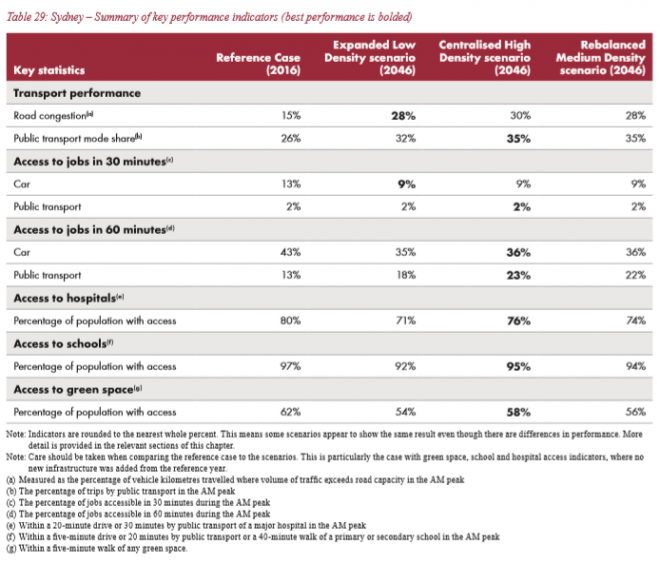
All of which reminds me of Upton Sinclair’s famous quote:
“It is difficult to get a man to understand something, when his salary depends on his not understanding it.”

